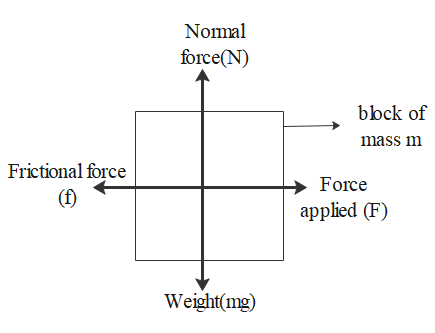
What is mu in physics?
Answer
498.6k+ views
Hint:The ratio of the frictional force resisting motion of two surfaces in contact to the normal force pressing the two surfaces together is known as the coefficient of friction. The Greek letter mu $\left( \mu \right)$ is usually used to represent it. Friction is developed when one surface is in contact with the other. It can be defined as a force that will be retarding an object from moving.
Complete step-by-step solution:
1.Friction is created when one surface rubs against another. It's a force that can stop an object from moving.
2. The Greek letter "mu" $\left( \mu \right)$ is assigned to the coefficient of friction, and it is unit less. The normal force on an object is multiplied by the friction force.
3.The Newton is the unit of friction (N). For static friction and kinetic friction, the coefficient of friction has different values.
4.The frictional force resists the force applied to an object in static friction, and the object remains at rest until the static friction force is overcome. The frictional force resists an object's motion in kinetic friction.
The frictional force can be written as,
$\vec{f}=\mu \vec{N}$
The forces acting on a block is shown below,

Note: Friction is the force that opposes motion between any two surfaces that come into contact with one another. Static, sliding, rolling, and fluid friction are the four types of friction. Solid surfaces experience static, sliding, and rolling friction. The normal force is the force exerted by surfaces to keep solid objects from passing through them. A contact force is a normal force. If the surfaces of a table and a box are not in contact, they cannot exert normal forces on each other.
Complete step-by-step solution:
1.Friction is created when one surface rubs against another. It's a force that can stop an object from moving.
2. The Greek letter "mu" $\left( \mu \right)$ is assigned to the coefficient of friction, and it is unit less. The normal force on an object is multiplied by the friction force.
3.The Newton is the unit of friction (N). For static friction and kinetic friction, the coefficient of friction has different values.
4.The frictional force resists the force applied to an object in static friction, and the object remains at rest until the static friction force is overcome. The frictional force resists an object's motion in kinetic friction.
The frictional force can be written as,
$\vec{f}=\mu \vec{N}$
The forces acting on a block is shown below,

Note: Friction is the force that opposes motion between any two surfaces that come into contact with one another. Static, sliding, rolling, and fluid friction are the four types of friction. Solid surfaces experience static, sliding, and rolling friction. The normal force is the force exerted by surfaces to keep solid objects from passing through them. A contact force is a normal force. If the surfaces of a table and a box are not in contact, they cannot exert normal forces on each other.
Recently Updated Pages
The number of solutions in x in 02pi for which sqrt class 12 maths CBSE

Write any two methods of preparation of phenol Give class 12 chemistry CBSE

Differentiate between action potential and resting class 12 biology CBSE

Two plane mirrors arranged at right angles to each class 12 physics CBSE

Which of the following molecules is are chiral A I class 12 chemistry CBSE

Name different types of neurons and give one function class 12 biology CBSE

Trending doubts
One Metric ton is equal to kg A 10000 B 1000 C 100 class 11 physics CBSE

What is 1s 2s 2p 3s 3p class 11 chemistry CBSE

Discuss the various forms of bacteria class 11 biology CBSE

State the laws of reflection of light

Explain zero factorial class 11 maths CBSE

An example of chemosynthetic bacteria is A E coli B class 11 biology CBSE




